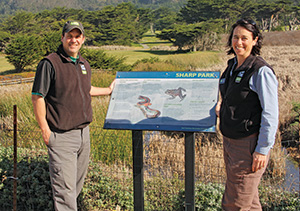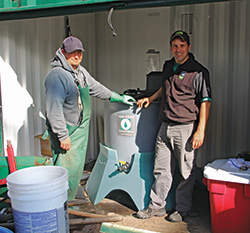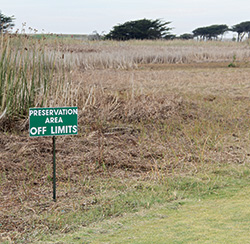A sharp mind at Sharp Park
You’ve read all about the case. You know about the red-legged frog and the California garter snake. Now meet the man behind Sharp Park Golf Course, superintendent Wayne Kappelman, our winner of the 2013 Herb Graffis Businessperson of the Year Award.

“For our department, this property has been very innovative,” says San Francisco’s Recreation and Parks Open Space Manager, Lisa Wayne, pictured with Kappelman. “Things that have worked here have translated to other properties. It’s having a larger impact on our overall chemical use on all our golf properties, lawns and sports fields.” Photo: Sharp Park Golf Course
There are frost delays, and there are fog delays. But frog delays?
San Francisco’s Sharp Park Golf Course has no problem delaying golfers from teeing off on the back nine in the early morning hours. That’s because the red-legged frog is a threatened species, and that’s the time they sometimes emerge from the lagoon on No. 12, especially in the winter months.
Sharp Park Golf Course is familiar to many in the golf industry, but not for the right reasons. The focus hasn’t been on the course being an Alistair MacKenzie design, or one of San Francisco’s affordable municipal courses, host to 50,000 rounds a year. Most disappointing, the Herculean efforts of the crew to keep the course harmonious with nature is rarely brought up.
No, the headlines that Sharp Park makes regard the lawsuit the course has been embroiled in for the last several years. Misguided environmentalists — who won’t get much space here — have tried shutting the course down because the endangered California garter snake and the threatened red-legged frog both live on the course. But on Dec. 6th, 2012, Judge Susan Illston dismissed “Wild Equity Institute, et al v. the City and County of San Francisco, et al” after reviewing a Biological Opinion and Incidental Take Statement issued by the U.S. Fish & Wildlife Service.
Though the environmental groups have filed an appeal, it seems that this match play has at least gone dormie in favor of Sharp Park Golf Course. The battle has been fought valiantly in court rooms by such groups as the San Francisco Public Golf Alliance. But there is a front line to this battle, and the man leading that charge is the man on the ground, Wayne Kappelman, superintendent at Sharp Park Golf Course, winner of Golfdom’s Herb Graffis Businessperson of the Year award.
Decision for environment
The Herb Graffis Businessperson of the Year Award is named in honor of Golfdom’s founder, Herb Graffis, who began the magazine in 1927. Now in its second year, the award coincidentally goes to another Dr. Alister MacKenzie course, and another course in Northern California. (Last year’s award went to Paul Chojnacky, then at Pasatiempo Golf Club in Santa Cruz.)
Kappelman, going on his fourth year as the superintendent at Sharp Park, is an introspective, humble, soft spoken man with a Wisconsin accent. To give an idea of the character of Kappelman, realize that he took six weeks off work after hosting the 2009 President’s Cup at Harding Park Golf Club to teach English to Buddhist monks in Laos.
“I’m very proud that the course has been all organic since before the environmentalists started their court case against us. Most of our decisions are based on the environment more than the golfing public, but we have a good balance between the two,” Kappelman says. “We provide good playing conditions while still protecting the environment.”
The work of Kappelman and his colleagues, including Lisa Wayne, Open Space Manager for San Francisco’s Recreation and Parks Department, has ensured a win for Sharp Park, but perhaps also golf in general. Had the tide turned the other way, it could have set a dangerous precedent for not just other golf courses, but other green spaces, says Mark Dwayne, owner of Sharp Park’s clubhouse and pro shop.
“You don’t expect to go to work one day, find a red-legged frog, then there are suddenly environmental groups, committees, groups of people every week wanting to go out on the golf course interrupting play,” Dwayne says. “I’m glad this didn’t go any further than it did, because I think it would have set the precedent that if you find an endangered species, then agencies can come in and shut you down, whether it be a municipality, someone’s private property, a farm or a vineyard.”
Friends of frogs

“I feel we work more on the soil than the plant here,” Kappelman says as he observes his compost tea equipment. “There will be times when you see our greens not look so great here. We just have to ride it through. In the long run, we have pretty healthy turf because of it.” Photo: Sharp Park Golf Course
Neither Kappelman nor Dwayne has ever seen the endangered California garter snake on the course. The threatened red-legged frog is a different story.
Near No. 12, one of the most scenic holes on the course, is Horse Stable Pond and Laguna Salada. All of the water on the course — there is no man-made drainage — flows to this area. After any winter rain event, Lisa Wayne and her staff are on their way to the course.
They’re on an egg hunt.
“It’s a moment’s notice kind of thing, drop everything,” she says.
That’s because if frog egg masses are found, the water level must then remain static to ensure their survival. No more pumping water off the course into the ocean until the eggs have hatched.
“Two years ago we had a huge rain event. The whole valley flooded,” Kappelman recalls. “Once it got to that level, the frogs laid their eggs, then we can’t pump. No. 14 fairway was underwater for three or four weeks. We had to route people around that area of the fairway.”
Once they hatch, it’s not uncommon to see the frogs on the area of the course along the sea wall, says Felipe Ochoa, who is the closest person Kappelman has to an assistant superintendent on his staff of six.
“Lisa Wayne has trained us,” Ochoa says. “Now I know that on this area of the course, it’s something to look out for. We communicate about it first thing in the morning.”
Kappelman will personally walk the areas near Laguna Salada to make sure it’s safe to mow, or even operate equipment.
“We’ll either not mow, or I’ll walk in front of the mower, I’ll check an entire area to make sure it’s safe to operate a mower or even have golfers in the area,” he says. “If we see any frogs, we’ll stop play for an hour or two. The frogs usually move out by sunrise, but I want that cushion of 30 minutes, 45 minutes, so they’re well on their way back to the lagoon and not in harm’s way.”
Sharp Park roadmap
Lisa Wayne oversees 32 green spaces for San Francisco, but none are as large or as unique as Sharp Park. The course itself is 150 acres. The entire park, which includes hiking, a beach and an archery range, is 430 acres.
Wayne says that there has been a lot of misinformation about how the course operates.
“I still have people ask me, ‘Why are you draining the marsh?’ and we haven’t done that in years,” she says. “There are a lot of things that are routine here, things that Wayne implemented — there are no chemical inputs on the golf course, there are more than five acres that we’ve stopped mowing. The golfers know, but not so much the environmental community. It’s a long process to inform such a massive amount of people.”
With the creation of the Biological Opinion, there is now a roadmap to what the federal government expects from Sharp Park in terms of mitigating impact. “We have a lot to do here in these next three years to meet those requirements,” Wayne says.
Kappelman made the decision that the course would only fertilize tees, greens and green surrounds, and only organically. The crew regularly brews compost tea to meet these demands.
“Organic fertilizer is more expensive, but we don’t fertilize fairways or rough at all,” Kappelman says. “That decision has saved us tens of thousands of dollars. We made that decision for the environment, and for budgetary reasons, but mostly for the environment.”
“Wayne’s an educated man, and I believe he’s an environmentalist as well. On his days off, he and his wife come out here and take wildlife photos,” says Dwayne. “He has a work ethic that carries through to the rest of the crew.”
Rustic beauty

Kappelman has added five acres of natural areas to the golf course. “It’s one of the things I like about golf,” says Kappelman’s right-hand man, Felipe Ochoa, “They’re natural wildlife areas in a lot of respects.” Photo: Sharp Park Golf Course
Around the clubhouse bar, the regulars are buzzing about the San Francisco 49ers being in the Super Bowl. The course may have endangered species hiding in its lagoons, but in here, there’s no danger of any kind. Just good common folks.
“It’s very blue collar. We have all ages, nationalities. They try to push that this is a rich white man’s golf course, but the green fees are no more than $40. For resident seniors, the price is $15,” says Dwayne. “We get 50,000 golf rounds. That’s a lot of people to turn away. The environmentalists argue that there are other places to play, but not like this and not at this price.”
Ask Kappelman about his biggest challenge maintaining the course, and there is no talk of environmentalists, red-legged frogs, or snakes.
“We’re short-staffed. We don’t have enough people to maintain the course,” he says. “We have an old infrastructure, an old irrigation system, an old computer system. Not a lot of money has been put into modern equipment. But when a new irrigation system costs $2 million or $3 million, that’s a lot of money when you don’t know who is going to own it because of the court cases. I understand why the city has been reticent to invest the money.”
Yet the course is popular. And even more important, profitable.
Duncan Schlicht drives over an hour, over the Bay Bridge, from LaFayette, Calif., to get to Pacifica to play the course.
“I love everything about it, especially late in the afternoons when the shadows get long,” Schlicht says. “Hopefully they’ve found a compromise, because shutting it down wouldn’t be the answer, it’d be a disaster.”
Connie Chan, deputy director of public affairs for San Francisco Recreation and Parks, hopes that more people can understand the effort that goes into maintaining Sharp Park.
“The majority of the media has covered the lawsuits, which has short-changed (Kappelman and Wayne),” she says. “They don’t get to talk about their management and coordination because of the lawsuits.”
Kappelman says he has learned to accept that because of the way they manage the course, perfection is something he’ll never achieve.
“I’ve had to mellow out a little. I’m a little more easy-going. Some things you just have to live with and be patient,” he says. “Weeds are going to occur. I just hope the golfing public understands that we’re not seeking perfection, we just want a good value and a decent golf course.”
“I think most of the regulars know the balance we’re trying to strike,” Lisa Wayne says. “Wayne’s not operating this like a normal golf course with the level of chemical pesticides and herbicides. Consequently, it’s a little more… rough around the edges.”
“Rustic!” Kappelman exclaims with a smile.
It’s the first time Kappelman has gotten excited. Working in such circumstances, having to constantly defend his work, his demeanor might be perfect for Sharp Park.
“I’m a public spokesperson for the course a few times a week,” Kappelman says. “Some people ask why we do this, why we mow that. Most of the regulars understand. But for example, there’s no drainage on the course; it just drains naturally. When it’s raining, it’s wet. Sorry. We work through it.”
‘When it’s raining, it’s wet. We work through it.’
Makes one wonder, if Kappelman taught the Buddhist monks English… what all did they teach him?
Photos by: Seth Jones
 The Herb Graffis Businessperson of the Year award is named in honor of Golfdom’s founder, World Golf Hall of Fame member Herb Graffis. Graffis was one of the first people to look at golf as a business when he and his brother Joe founded Golfdom in 1927. With his foresight, Graffis helped advance the game in numerous ways, from co-founding the National Golf Foundation and founding the Golf Writers Association of America to his work advocating on behalf of superintendents and helping elevate their profile.
The Herb Graffis Businessperson of the Year award is named in honor of Golfdom’s founder, World Golf Hall of Fame member Herb Graffis. Graffis was one of the first people to look at golf as a business when he and his brother Joe founded Golfdom in 1927. With his foresight, Graffis helped advance the game in numerous ways, from co-founding the National Golf Foundation and founding the Golf Writers Association of America to his work advocating on behalf of superintendents and helping elevate their profile.
The award includes a Golfdom cover story celebrating the person’s accomplishments, as well as expenses-paid trips to both the Golfdom Summit and the Golf Industry Show. It is in all due respect that we present this award in Mr. Graffis’ honor.
Click here to nominate someone for the Herb Graffis Businessperson of the Year award.








